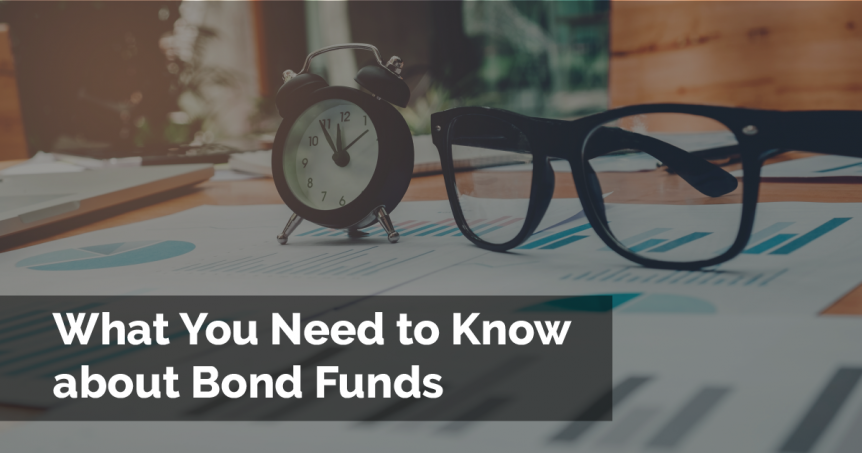Most investors transition their portfolios from equities to bonds as they move closer to retirement. For example, a 2050 target retirement fund may hold 90% equities and 10% bonds whereas a 2025 target retirement fund may hold 64% equities and 36% bonds. Bonds are more conservative than equities and provide bondholders with regular income during retirement, which makes them more attractive as retirement draws closer.
In this post, we will take a look at what bond funds are and how to determine if they’re right for your portfolio.
What Are Bond Funds?
Bonds are simply a form of debt used by governments and corporations to raise capital. For example, a city might issue a bond to build a bridge and promise to pay bondholders regular interest payments until the maturity date when the full amount is returned. The safest bonds are issued by the U.S. government – known as Treasuries – but there are also very risky bonds – such as junk bonds – that may be issued by individual corporations in a poor financial condition.
You may be tempted to build your own bond portfolio, but it often requires tens of thousands of dollars and a lot of active maintenance. Bond funds offer a more efficient way to invest in bonds by pooling money from multiple investors to purchase a broad portfolio. Some bond funds mimic the broad market by investing in a variety of short- and long-term bonds, while others invest in specific subsets of the market, such as municipal bonds.
When evaluating bond funds, you should take into account the share price, yield, tax-equivalent yield, and total return. You should also be aware of the fund’s expense ratio (e.g. management costs), as well as potential sales charges (e.g. loads), redemption fees, annual account fees, or other fees. These fees can have a significant impact in the long-term since you’re foregoing the compounding effects of any money that’s paid in fees.
The taxation of bond funds also differs from conventional equity funds. You might owe taxes on the distribution of dividend income (ordinary income), distribution of capital gains (ordinary income or capital gains), and the capital gains when the fund is sold (ordinary income or capital gains). That said, some government and municipal bond funds may have tax advantages that you may want to consider depending on your personal tax bracket.
Benefits of Bond Funds
There are many benefits associated with investing in bond funds as opposed to individual bonds or other fixed income securities.
- Diversification – Bonds have higher face values than equities, in most cases, which means creating your own diversified portfolio would require a large investment. Bond funds let you invest in an existing portfolio of individual bonds at a relatively low cost. The fund manager also takes care of ensuring that the portfolio remains diversified over time to maximize your risk-adjusted returns.
- Due Diligence – The bond market is a lot less transparent than equity markets. For example, it’s a lot easier to look up a public company’s 10-K annual report than find a city’s budget and balance sheet. Bond funds employ professional managers that have the expertise and technology to research the creditworthiness of bond issuers and stay ahead of any problems that may arise.
- Liquidity & Convenience – The bond market is less liquid than the equity markets, which can make it difficult to buy and sell bonds at reasonable prices. Bond funds issue mutual fund shares or exchange-traded shares, which are much more liquid and convenient to buy and sell than individual bonds. Many funds also let you reinvest any distributions and easily manage the portfolio over time.
- Regular Income – Most bond funds pay regular monthly income that they generate from their bond portfolios. Often times, these distributions are much more attractive and reliable than the dividend distributions offered by equities.
- Tax-Free Income – Some bond funds can be used to mitigate your tax burden. For instance, many municipal bond funds provide tax advantages that can help with planning out your investment tax exposure.
Drawbacks of Bond Funds
There are also many drawbacks associated with bond funds that you should carefully consider before investing in them.
- Interest Rates – Bond prices are inversely related to interest rates. This means that bond prices fall when interest rates rise and vice versa. The longer a bond’s maturity, the greater the sensitivity to interest rate risk. In terms of bond funds, those with longer average maturities will have a net asset value that reacts more to interest rate changes.
- Credit Risk – There’s always a risk that a bond issuer will default on their obligations. While this isn’t a big problem for many bonds, riskier bonds may have a higher credit risk than appropriate for retirement-aged investors. Bond funds are often classified based on their investment grade quality of the individual bonds in their portfolio and these attributes are extremely important to consider.
- Principal Risk – High-quality bonds have relatively little risk if you hold them until maturity, but bond funds are a different story. When you sell shares of a fund, you receive its current net asset value, which is the value of all of its holdings divided by the number of fund shares. If the net asset value is lower on the day you sell than the day you purchase, you can lose money.

Alternatives for Fixed Income
Bond funds are the most popular fixed income security for most investors, but that doesn’t make them right for every investor. Fortunately, there are many different alternatives that you might want to consider to bonds and bond funds to generate a regular income.
- Certificate of Deposits – CDs provide government insurance of principle and interest, a stated maturity date and amount, and predictable interest checks until that date, which makes them a safer bet than bonds. The downside is that you can’t easily sell them before the maturity date without paying a penalty and the interest rates tend to be much lower than bonds.
- Savings Bonds (Series I) – Savings bonds have interest rates tied to the consumer price index (resetting on May 1 and Nov 1 each year). Bond interest is also exempt from state taxes and you can pay federal taxes each year or wait until the bond matures. The downside is that you must hold five years to sell with no penalty and the interest rates tend to be much lower than bonds.
- Writing Call Options – Covered call options on an underlying equity position is a great way to increase income with relatively low risk. In essence, you’re selling the right to buy shares of stock that you own in exchange for a premium. The premium serves as a virtual dividend each month on the stock. You also benefit from holding the underlying stock, which may appreciate in value up to the strike price of the option.
If you’re interested in alternatives to bond funds, including writing call options, The Snider Investment Method provides a simple and easy retirement education so you can earn a portfolio paycheck after you retire. Our proprietary software guides you through the trading process each month and leaves no room for emotions or other common mistakes made by the average investor. Learn more by taking a look at the Snider Investment Method Owner’s Manual.







